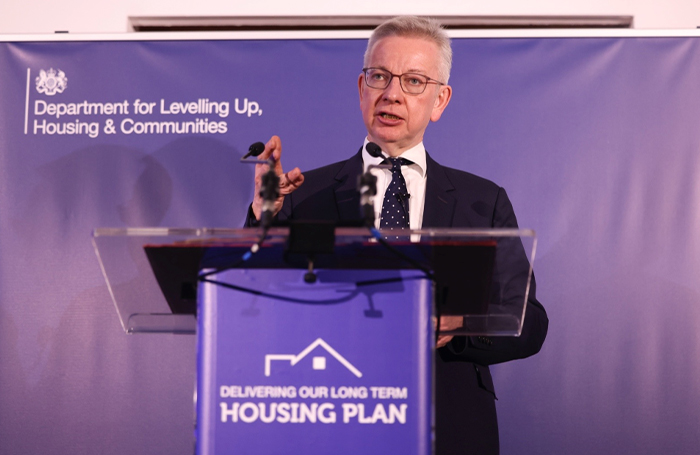The Secretary of State for Levelling Up, Housing and Communities, the Rt Hon. Michael Gove, paid a visit to the Royal Institute of British Architects at 66 Portland Place in London this week to kick off the festive break with a raft of planning policy announcements, including changes to the National Planning Policy Framework (NPPF).
This long-awaited update formed part of the next stage in the Department for Levelling Up, Housing and Communities’ (DLUHC) Long Term Plan for Housing. We responded to the first stage of DLUHC’s plan in July, where the department focused on expansions to planning resource, proposing an extension to Permitted Development Rights (PDR) and increasing developer contributions.
This time around, the Secretary of State’s vision was firmly fixed on what he described as the BIDEN principles – beauty, infrastructure, democracy, the environment and neighbourhood.
With significant changes to the planning system on their way as a result of the recently passed Levelling Up and Regeneration Act and now the revised NPPF, we examine what this may mean.

Meeting housing need
Housing need was at the top of the agenda, with emphasis placed on the role of local plans in allowing local planning authorities (LPAs) to bring forward genuinely plan-led development.
Though housing supply was front and centre, announcements also stressed the need to deliver associated infrastructure and amenities – a lack of which can cause opposition to development, as well as stretching existing services.
Gove’s approach this week focused primarily on sanctions, announcing a number of possible consequences for local authorities that fail to deliver up-to-date local plans. For those authorities, measures requiring annual updates to housing land supply will be introduced, and those who still fail to produce plans will be subject to the presumption in favour of sustainable development.
Additionally, changes to the application of the Housing Delivery Test will mean that such LPAs face tougher consequences should their past housing delivery fall below requirements.
However, there were also “rewards” for local authorities that do deliver up-to-date local plans, such as the removal of the requirement to annually demonstrate a five year housing land supply. LPAs at an advanced stage of plan-making, and with proposed allocations to meet housing need, will only need to demonstrate a four, not five, year supply for a period of two years.
This focus on meeting housing need in a plan-led way is a welcome step, and the due attention paid to the importance of wider infrastructure is particularly commendable. With this said, many LPAs remain deeply overstretched despite recent funding increases, and producing high quality local plans at pace requires not only an injection of capacity but also skill.
Moves to lessen the need to demonstrate housing land supply may also be a cause for concern, even if only authorised for high performing LPAs, and their effect will need to be analysed closely to avoid any detrimental effect on building the homes we need.
Planning fees
Following a consultation earlier this year, this month sees a confirmed increase to fees for planning applications. With LPAs experiencing one of the most severe cuts in terms of real terms budget allocation in recent years, this is a welcome step to raise some much-needed revenue.
In our response to this consultation, we urged the government to take steps to guarantee that any proposed increase in fees is ringfenced for the use of LPAs. While this was not confirmed at the time, Gove’s speech reiterated that local authorities will be “obliged” to spend the proceeds of the increase on planning services, with clear guidance that there should be “no decrease in authorities’ spend on planning from their general fund”.
It’s unclear whether this constitutes mandatory ringfencing, but Gove’s intentions here are clear – in line with our recommendation, funding for the planning system must remain in the planning system. We will continue to work to ensure that this is the case.

Balancing density and delivery
Keen watchers of planning policy under Gove’s leadership will find it unsurprising that encouragement for housing and infrastructure delivery was tempered by references to appropriate density and character.
Steps to “provide the right homes in the right places” rather than unfettered development include guidance in the updated NPPF for community-led development and self- and custom-build, with LPAs encouraged to support small sites being brought forward.
In addition, revisions to the NPPF make clear that the “urban uplift” applied to the standard method must accommodate greater density in existing urban centres, rather than being applied to surrounding areas. Such a move is likely aimed not only to make the most of existing infrastructure but also to look to preserve “character” in places which are less densely developed.
The prickly question of the Green Belt also comes into consideration here, with support for the “gentle densification” of urban areas preferred to Green Belt development. As is already the case, Gove reiterated that there is no requirement on local authorities to review or alter Green Belt boundaries if this would be the only way to meet housing need.
It remains to be seen if these checks and balances will hinder the government’s target of building 300,000 additional homes a year. It will likely take considerable time to see the impact of these planning reforms, and regular analysis to ensure their efficacy is crucial.
What’s next?
A series of consultations – including further consultation on the NPPF – are due to land in 2024, and the RIBA Policy and Public Affairs team will be hitting the ground running to keep high quality, sustainable development front and centre.
Until then, we wish all our members a restful festive period and a happy new year.









